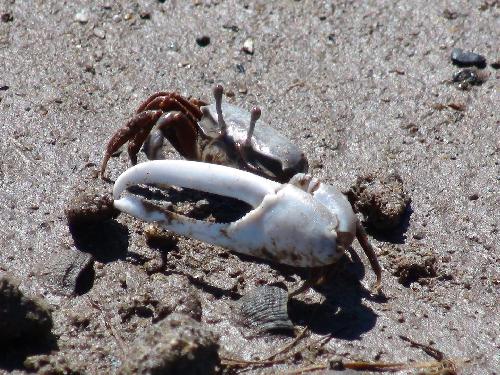Male fiddler crabs bluff their way through fights. They also adapt their combat strategies if they have lost their original enlarged claw and have regrown a more fragile, weaker one. These are some of the findings of wildlife researchers Daisuke Muramatsu of Kyoto University and Tsunenori Koga of Wakayama University in Japan, who spent time on a mudflat watching how fiddler crabs use deception to their favour. Their study is published in Springer's journal Behavioral Ecology and Sociobiology.
Male fiddler crabs (Uca lactea) fight aggressively over territory and burrows. Their prized weapon is their enlarged major claw, which grows on either the left or right side. During Muramatsu and Koga's observations of a dense crab colony in the Waka River estuary in Japan, they videotaped 138 such fights. In general, those with longer claws came up trumps. Animals that participated in these bouts were caught and their body parts thoroughly examined, measured and marked.
The researchers distinguish original from regrown claws by checking whether these had teeth in their gape or not. Although regenerated claws often grow back to the same size as that of the original, these replacements are of weaker standard. Based on Muramatsu and Koga's observations, fiddler crabs seem unable to visually discriminate one from the other, because males with regrown claws (so-called regenerated males) were not picked on more to fight with than others. Of the 138 fights observed, only 42 were between males with original claws and those with regrown ones.
 A male fiddler crab is equipped with a fragile regenerated claw. Credit: Daisuke Muramatsu
A male fiddler crab is equipped with a fragile regenerated claw. Credit: Daisuke Muramatsu
The researchers saw no fight which included a male whose lost claw had not yet grown back to its original size. This suggests that these crabs are unwilling to engage in fights until their claws are completely regrown. Once in place, regenerated males chose smaller and opposite-handed opponents as a way of protecting their inferior regrown claws from possible injury. Claws are generally grappled more tightly in same-handed fights.
Males with regrown claws make a show of being aggressive to deter opponents, but surrender easily when the fight escalates in intensity. These initial bluffing tactics to ward off opponents seem to be partially successful, because they are not engaged in fights more than others. Regenerated males are victorious in two out of every five such encounters.
Males with their original claws intact tend to choose same-handed opponents. As part of their own counter-bluff tactics, they persist in contests even when their opponents are larger. They go into a fight assuming that the opponent has a regenerated claw and, if this is the case, the regenerated male will therefore retreat.
"Fiddler crab males adapt their fighting tactics and choice of opponent depending on whether they have lost their major claw," says Muramatsu, who adds that this shows that animals are able to switch tactics during their lifetime.
"The findings are in line with current theories that predict that animal signals are generally honest, but each signalling system allows for deception," adds Koga.
source: Springer